Class 7 Social Science Chapter 7 Let's Explore - The Gupta Era: An Age of Tireless Creativity
Page 150: Think About It
Q: Why do you think kings chose to proclaim their achievements in the form of inscriptions?
Ans: Reasons for Inscriptions:
- Propaganda and Legacy: Inscriptions, like the prayaga praśhasti by Harisena, publicized achievements (e.g., Samudragupta’s conquests) to enhance the king’s reputation and ensure a lasting legacy, as seen with the Iron Pillar’s tribute to Chandragupta II.
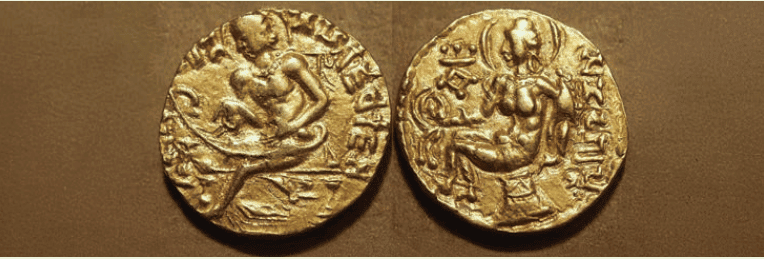 A seated Samudragupta, playing the veena; on the reverse side, goddess Lakṣhmī
A seated Samudragupta, playing the veena; on the reverse side, goddess Lakṣhmī - Political Authority: By detailing victories and titles (e.g., maharajadhiraja), inscriptions reinforced the ruler’s supreme power, legitimizing their rule over subjects and tributaries.
- Public Communication: Written in Sanskrit or Prakrit, inscriptions on pillars or copper plates were accessible to elites and priests, spreading the king’s narrative across regions, as with Prabhāvatī Gupta’s temple inscriptions.
- Religious Merit: Dedications to deities like Vishnu in inscriptions linked royal achievements to divine favor, enhancing spiritual authority, a practice common in Gupta art.
- Context: Inscriptions were durable, unlike oral traditions, ensuring long-term impact, as evidenced by the rust-resistant Iron Pillar’s survival. They also served administrative purposes, like recording land grants, reflecting governance efficiency.
Page 151: The Gupta Era (Section: Some Literary Sources)
Q: In the Grade 6 chapter 'Timeline and Sources of History', we listed multiple sources that help us understand the past. Compile a list of the sources we have referred to so far in the chapter. What did we learn from each source?
Ans: List of Sources and Learnings:
Iron Pillar Inscription:
- Description: Inscription in Mehrauli, Delhi, dedicated to Vishnu, mentioning King ‘Chandra’ (Chandragupta II).
- Learning: Reveals advanced metallurgy (rust-resistant pillar), Chandragupta II’s devotion to Vishnu, and his military achievements, indicating Gupta technological and cultural prowess.
Prayaga Praśhasti:
- Description: Pillar inscription in Prayagraj by Harisena, praising Samudragupta.
- Learning: Details Samudragupta’s conquests, ambition to unify the Earth (dharani-bandha), and patronage of art, learning, and trade, showcasing Gupta military and cultural achievements.
Coins:
- Description: Gold coins of Chandragupta I with Kumāradevi and Lakshmi (Fig. 7.4), Samudragupta as a veena player (Fig. 7.6), and ashvamedha coins (Fig. 7.7).
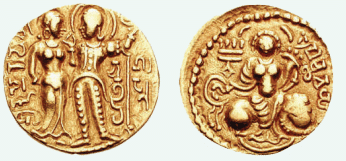 Gold coin featuring King Chandragupta I with his queen, Kumāradevī; on the reverse side, a seated goddess identified as Lakṣhmī
Gold coin featuring King Chandragupta I with his queen, Kumāradevī; on the reverse side, a seated goddess identified as Lakṣhmī - Learning: Reflect strategic alliances (Chandragupta I’s marriage), cultural patronage (Samudragupta’s musical depiction), and royal rituals (ashvamedha), highlighting Gupta wealth and legitimacy.
Vishnu Purāna:
- Description: Literary text specifying Gupta territorial extent.
- Learning: Outlines core regions (Anuganga, Prayāga, Sāketa, Magadha) and broader empire scope, confirming the Gupta Empire’s vast geographical reach beyond the Gangetic basin.
Faxian’s Travelogue:
- Description: Account of Chinese traveler Faxian (5th century CE) on Gupta society.
- Learning: Describes a prosperous, happy society with minimal bureaucracy, charitable institutions, and wealthy Vaishya traders, but also notes harsh treatment of chandālas, revealing social structure and inequalities.
Q: Take a political map of India and locate the present-day states and Union territories where the Guptas ruled (see Fig. 7.8). Mark these states on the map and count how many you found. Then, compare your findings with your friends to see if everyone got the same number or discovered something different!
Ans: Activity Instructions:
Map Reference: Use Fig. 7.8 showing the Gupta Empire’s extent, covering most of north and west India, parts of central and east India, and claims down to the Pallavas on the east coast.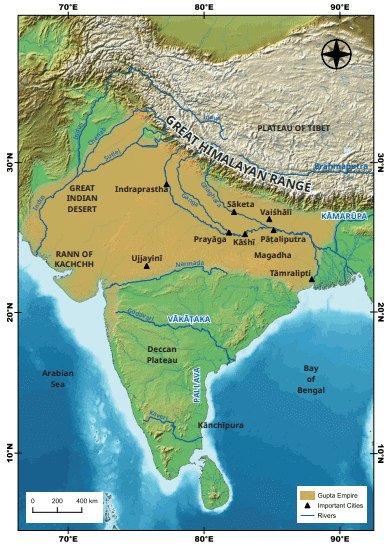 The Gupta Empire’s extent.
The Gupta Empire’s extent.
Steps:
- Obtain a political map of modern India.
- Identify and mark present-day states and Union territories within the Gupta Empire’s boundaries (Page 151), including:
- Uttar Pradesh (core region, Pātaliputra, Sāketa, Prayāga).
- Bihar (Magadha).
- Madhya Pradesh (Udayagiri caves).
- Delhi (Mehrauli Iron Pillar).
- Rajasthan, Haryana, Punjab, Himachal Pradesh (northwest extent).
- West Bengal, Jharkhand, Odisha (eastern regions).
- Parts of Gujarat, Maharashtra (western influence).
- Parts of Andhra Pradesh, Tamil Nadu (brief conquests, per Fig. 7.8).
- Count the marked states/Union territories (approximately 12–14, depending on interpretation of Fig. 7.8’s boundaries).
- Compare with classmates to verify accuracy and discuss variations (e.g., debates over partial control in southern states).
Findings:
- The Gupta Empire spanned a vast area, with core control in the Gangetic plains and influence extending to allies like the Vākātakas.
- Variations may arise due to unclear boundaries (e.g., Pallava regions) or differing map interpretations.
Page 153: A Traveller’s Account of Indian Society in the Gupta Age
Q: Read the excerpt from Faxian given above and identify the key features of the society he describes. Write down your observations and compare your notes with your friends - you might be surprised to see how differently others interpret the same text!
Ans: Key Features from Faxian’s Excerpt:
- Prosperous and Happy Population: Faxian notes numerous, happy people, indicating a stable, thriving society under Gupta rule (Page 153).
- Minimal Bureaucracy: No need to register households or deal with officials, suggesting efficient, non-intrusive governance.
- Salaried Guards and Attendants: Indicates a professional administrative and military system, supporting empire stability.
- Wealthy Urban Centers: Great cities in the Gangetic plains with rich Vaishya (merchant/trader) inhabitants, showing economic prosperity and trade vibrancy (Page 153).
- Charitable Institutions: Vaishya families established houses for charity, medicine, and care for the poor, orphans, and sick, highlighting social welfare and compassion (Page 153).
- Organized Urban Planning: Well-maintained lanes and beautiful homes of Vaishya elders and foreign merchants, indicating advanced urban infrastructure (Page 153).
- Social Inequalities (from broader travelogue, Page 154): Harsh treatment of chandālas (outcastes) living outside cities, revealing social stratification despite prosperity.
Observations:
- The society was economically robust, with trade and agriculture supporting wealth (Page 156), and culturally inclusive, as Gupta rulers patronized multiple traditions (Page 156).
- Governance balanced local autonomy (Page 156) with centralized revenue collection, fostering stability noted by Faxian.
- Social welfare coexisted with exclusion of outcastes, showing a complex social structure.
- Activity: Write these points in a notebook, then compare with friends to discuss interpretations (e.g., emphasis on charity vs. outcaste treatment). Variations may reflect focus on prosperity (urban wealth) or critique of inequalities (chandālas), encouraging debate on Gupta society’s strengths and flaws.
Page 155: Glimpses of the Gupta Empire (Section: New Kings ... New Titles)
Q: Observe the painting of Prabhāvatī Gupta sitting in her court (Fig. 7.10). Take note of the details-her attire, posture, the people around her, and the setting of the court. What do these elements tell you about her life, role, and the time she lived in? Discuss your observations in groups and share your insights with the class.
Ans: Analysis of Prabhāvatī Gupta’s Painting (Fig. 7.10, Page 155):
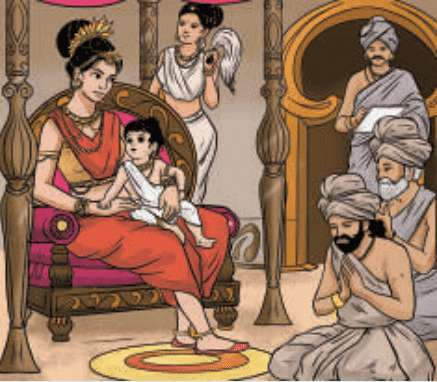 Fig. 7.10. An artist’s reimagination of Prabhāvatī Gupta sitting in her court
Fig. 7.10. An artist’s reimagination of Prabhāvatī Gupta sitting in her court
Attire:
- Likely ornate, flowing robes with intricate patterns, similar to Gupta royal depictions (e.g., Chandragupta I’s coin, Fig. 7.4, Page 149), signifying her high status as Chandragupta II’s daughter and Vākāțaka regent.
- Possible jewelry (necklaces, bangles) and a headdress reflect wealth and royal dignity, aligning with Gupta prosperity (Page 156).
Posture:
- Seated on a throne or elevated seat, exuding authority, as befits a regent ruler governing for her sons (Page 155). A composed, upright posture suggests confidence and leadership.
People Around Her:
- Likely includes ministers, advisors, and attendants, indicating a structured court, as seen in Gupta administration (Page 156). Presence of Vākāțaka and Gupta emissaries may reflect diplomatic ties (Page 155).
- Possible priests or devotees, given her Vishnu devotion and temple constructions (Page 155), highlighting her religious role.
Court Setting:
- Ornate with carvings or pillars, resembling Gupta art (e.g., Udayagiri caves, Page 160), suggesting a culturally rich environment.
- Organized layout with clear hierarchy (e.g., Prabhāvatī central, others subordinate) reflects Gupta governance’s efficiency (Page 156).
Inferences:
- Life: Prabhāvatī led a life of responsibility, balancing regency and motherhood, strengthened by her Gupta lineage and Vishnu devotion.
- Role: As regent, she maintained Vākāțaka-Gupta alliances, governed effectively, and patronized religious architecture, showing women’s influence in Gupta-era politics.
- Time Period: The 4th–5th century CE was marked by stability, cultural patronage, and advanced administration, enabling a woman like Prabhāvatī to wield power.
Page 159: New Ideas and Wonders: The Classical Age
Q: Let’s join Bhavisha and Dhruv with their time machine in the time of the Guptas. You are getting an opportunity to meet Āryabhața and Varāhamihira—what would you ask them? Divide the class into two groups and create a series of questions for an interview with them.
Ans: Activity Setup:
- Divide class into two groups: one for Āryabhața, one for Varāhamihira, based on their contributions.
- Each group prepares 5–7 questions for a fictional interview, focusing on their scientific work, life, and Gupta-era context.
Sample Questions:
For Āryabhața (Mathematician and Astronomer, Kusumapura, ~500 CE):
- How did you calculate the Earth’s rotation to explain day and night, and what inspired this idea?
- Your year length (365 days, 6 hours, 12 minutes, 30 seconds) is remarkably accurate. What tools or observations helped you achieve this?
- How did you develop the formulas in Āryabhațīya for solving equations, and are they still used today?
- What was it like studying in Kusumapura, and how did Gupta patronage support your work?
- How did you estimate the Earth’s size, and what challenges did you face without modern instruments?
- Were your ideas about solar and lunar eclipses accepted by other scholars in your time?
For Varāhamihira (Mathematician, Astronomer, Astrologer, Ujjayinī):
- In Brihat Samhita, you covered astronomy to farming. How did you combine traditional knowledge with observation?
- How did you predict weather patterns, and were your methods used by farmers in the Gupta Empire?
- What was Ujjayinī like as a learning center, and who were your teachers or peers?
- How did you approach architecture and town planning in your work, and did rulers consult you?
- As an astrologer, how did you balance science and belief in your predictions?
- Did your work influence trade or navigation in the Gupta Empire’s Indian Ocean network?
Execution:
- Groups write questions, ensuring they reflect Gupta-era advancements and the scholars’ interdisciplinary roles.
- Conduct mock interviews in class, with students role-playing Āryabhața and Varāhamihira, using document details (e.g., Chandragupta II’s patronage).
- Discuss how their answers highlight the Gupta period as a “classical age” due to scientific progress.
Page 160: The Quest for Beauty
Q: Take a close look at the samples of Gupta sculptures shown in Fig 7.15.1. and 7.15.2. By looking at the attributes, can you guess which deities are depicted here? Write your observations in the space provided and share your thoughts during the class discussion!
Ans: Analysis of Gupta Sculptures (Fig. 7.15.1 and 7.15.2, Page 162):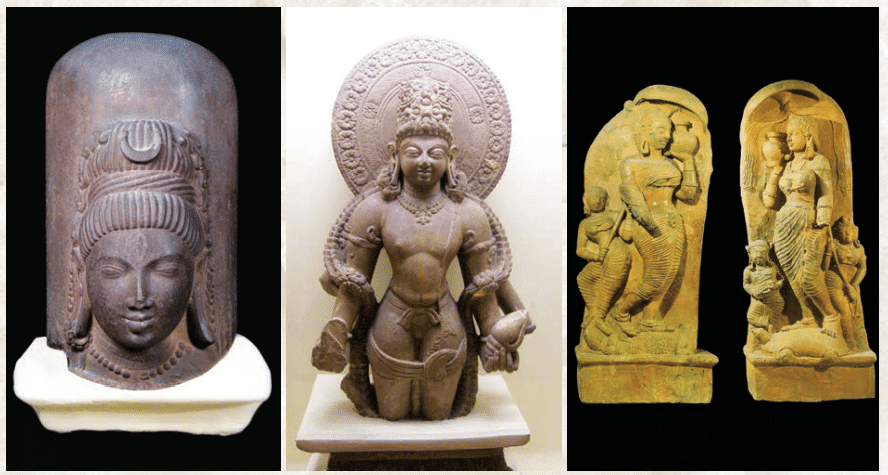 Fig. 7.15.1 to 7.15.3. In the 3rd image, these terracotta sculptures from the Gupta period (Ahichchhatra, western Uttar Pradesh) depict India’s sacred rivers, Ganga and Yamuna.
Fig. 7.15.1 to 7.15.3. In the 3rd image, these terracotta sculptures from the Gupta period (Ahichchhatra, western Uttar Pradesh) depict India’s sacred rivers, Ganga and Yamuna.
Fig. 7.15.1:
- Attributes: Likely depicts a deity with multiple arms (common in Gupta art, Page 160) holding objects like a conch, discus, or mace, and possibly standing or seated with a serene expression, reflecting Gupta aesthetic standards (Page 160).
- Guess: Vishnu, due to Gupta rulers’ devotion to Vishnu (Page 156) and frequent depiction in art (e.g., Udayagiri caves, Page 163). Attributes like a conch or discus are Vishnu’s symbols, as seen in the Kevala Narasimha temple (Page 155).
- Observations: The sculpture’s smooth modeling and detailed carving align with Sārnāth’s exquisite Buddha sculptures (Page 160), adapted for Hindu deities. The deity’s regal posture suggests divine authority, mirroring Gupta rulers’ chakravartin titles (Page 154).
Fig. 7.15.2:
- Attributes: Likely shows a deity with distinct symbols (e.g., trident, snake, or bull), possibly in a dynamic pose, with Gupta-style intricate details (Page 160).
- Guess: Shiva, as Gupta art included Hindu deities beyond Vishnu (Page 156), and Shiva was prominent in Pallava art (Page 161). A trident or bull (nandi) would confirm Shiva, as seen in Udayagiri carvings (Page 163).
- Observations: The sculpture’s robust form and high aesthetic reflect Gupta creativity (Page 160). The setting (e.g., temple-like) connects to Gupta patronage of religious art, as at Deogarh (Page 162).
Additional Context(from Fig. 7.15.3, Page 162):
- Fig. 7.15.3 depicts Ganga and Yamuna with vahanas (makara for Ganga, tortoise for Yamuna) and water pots, confirming river goddess iconography. This suggests Fig. 7.15.1 and 7.15.2 may also depict deities with clear attributes, aiding identification.
|
23 videos|204 docs|12 tests
|
















